Karel Appel
Christiaan Karel Appel (pronounced [ˈkrɪstijaːn ˈkaːrəl ˈɑpəl] (![]()
Karel Appel | |
|---|---|
.jpg) Karel Appel (1982) | |
| Born | Christiaan Karel Appel 25 April 1921 Amsterdam, Netherlands |
| Died | 3 May 2006 (aged 85) Zürich, Switzerland |
| Nationality | Dutch |
| Education | Rijksakademie |
| Known for | Painting, drawing, sculpture, wall-painting |
Notable work | |
| Movement | Cobra |
Childhood
Christiaan Karel Appel was born on 25 April 1921[1] in his parents' house at Dapperstraat 7 in Amsterdam, the Netherlands. As a child he was often called 'Kik'. On the ground floor his father, Jan Appel, had a barbershop. His mother, born Johanna Chevalier, was a descendant of French Huguenots. Karel Appel had three brothers.[1]
At fourteen, Appel produced his first real painting on canvas, a still life of a fruit basket. For his fifteenth birthday, his wealthy uncle Karel Chevalier gave him a paint set and an easel. An avid amateur painter himself, Chevalier gave his namesake some lessons in painting.[1]
Career
From 1940 to 1943, during the German occupation, Appel studied at the Rijksakademie van Beeldende Kunsten in Amsterdam, and it was there he met the young painter Corneille and, some years later, Constant; they became close friends for years. His parents opposed his choice to become an artist, leading him to leave home; this was also necessary because he needed to hide from the German police so that he would not be picked up and sent to Germany to work in the weapons industry.
Appel had his first show in Groningen in 1946. In 1949 he participated with the other CoBrA artists in the Stedelijk Museum Amsterdam; this generated a huge scandal and many objections in the press and public. He was influenced by Pablo Picasso, Henri Matisse, and the French brute-art artist Jean Dubuffet. In 1947 he started sculpting with all kinds of used materials (in the technique of assemblage) and painted them in bright colors: white, red, yellow, blue, and black. He joined the Experimentele Groep in Holland together with the young Dutch painters Anton Rooskens, Theo Wolvecamp, and Jan Nieuwenhuys. Later the Belgian writer Hugo Claus joined the group.
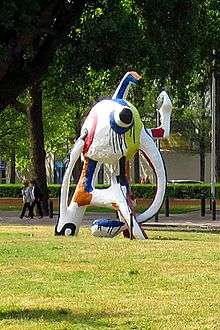
In 1948 Appel joined CoBrA (from Copenhagen, Brussels, Amsterdam) together with the Dutch artists Corneille, Constant, and Jan Nieuwenhuys (see also Aart Kemink), and with the Belgian poet Christian Dotremont. The new art of the CoBrA group was not popular in the Netherlands, but it found a warm and broad welcome in Denmark. By 1939, Danish artists had already started to make spontaneous art and one of their sources of inspiration was Danish and Nordic mythology. It was also in Denmark that the CoBrA artists started cooperating by collectively painting the insides of houses, which encouraged and intensified the exchange of the typical 'childish' and spontaneous picture language used by the CoBrA group.[2] Appel used this very intensively; his 1949 fresco 'Questioning Children' in Amsterdam City Hall caused controversy and was covered up for ten years.
As a result of this controversy and other negative Dutch reactions to CoBrA, Appel moved to Paris in 1950 and developed his international reputation by travelling to Mexico, the USA, Yugoslavia, and Brazil. He also lived in New York City and Florence. His first American gallery exhibition took place in 1954 at the Martha Jackson Gallery.[3] The following year his painting Child and Beast II (1951) was included in the influential exhibition, The New Decade at the Museum of Modern Art which featured the work of twenty-two European painters and sculptors including newcomers like Francis Bacon, Jean Dubuffet, and Pierre Soulages.[3][4] He is particularly noted for his mural work. After 1990 he became much more popular in the Netherlands; he had several big shows in Amsterdam and Bruxelles, organized by director Rudy Fuchs. Also, the CoBrA-museum in Amstelveen organized several shows featuring his work. He became the most famous Dutch CoBrA artist.

Appel's work has been exhibited in a number of galleries, including the Anita Shapolsky Gallery in New York City, Galerie Lelong in Paris, Galerie Ulysses in Vienna, and Gallery LL in Amsterdam.[5][6]
Death
Appel died on 3 May 2006 in his home in Zürich, Switzerland. He suffered from a heart ailment.[7] He was buried on 16 May 2006 at the Père Lachaise Cemetery in Paris, France.[8]
Years before his death, Appel established the Karel Appel Foundation, whose purpose is "to preserve [Appel's] artworks, to promote public awareness and knowledge of Karel Appel's oeuvre, and to supervise publication of the Oeuvre Catalogue of the paintings, the works on paper, and the sculptures."[9]
In 2002 a number of Appel's works went missing on the way to his foundation, an event that was not to be resolved before his death. However, in 2012 the works were found in a disused UK warehouse and returned to the foundation.[10]
In the wake of his death, the Foundation (based in Amsterdam) functions as his official estate in addition to its primary service as an image archive. The U.S. copyright representative for the Karel Appel Foundation is the Artists Rights Society.[11]
Gallery
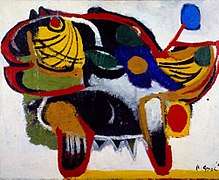 'Het Oerbeest / The Primeval', 1951; oil-painting
'Het Oerbeest / The Primeval', 1951; oil-painting_tijdens_een_interview%2C_Bestanddeelnr_133-1171.jpg) 'Portrait of Appel with his painting', 1954
'Portrait of Appel with his painting', 1954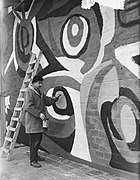 'Karel Appel, making a wall-painting in Rotterdam', 1955
'Karel Appel, making a wall-painting in Rotterdam', 1955- 'Portrait of Willem Sandberg', 1955; indian ink on paper
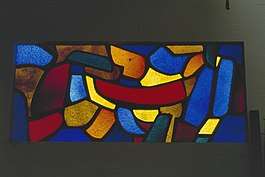 'Window in the Kruiskerk, church in Geleen, 1957; colored stained glass
'Window in the Kruiskerk, church in Geleen, 1957; colored stained glass.png) 'Tête de soleil / Sun-Head', c. 1960-63; oil on canvas
'Tête de soleil / Sun-Head', c. 1960-63; oil on canvas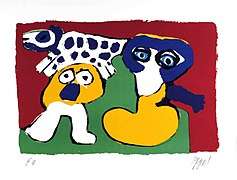 'no title', before 1977: colored silkscreen
'no title', before 1977: colored silkscreen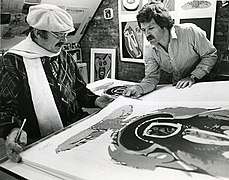 Karel Appel, 1979; signing his prints
Karel Appel, 1979; signing his prints.png) 'The Discovery', 1986; oil on canvas
'The Discovery', 1986; oil on canvas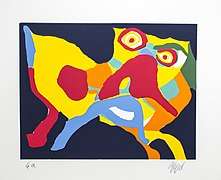 'no title', 1986; silkscreen
'no title', 1986; silkscreen.jpg) 'Frog and Cat', 1990; sculpture at Naoshima
'Frog and Cat', 1990; sculpture at Naoshima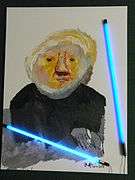 'Portrait of Rudi Fuchs', 2005; oil-painting & neon
'Portrait of Rudi Fuchs', 2005; oil-painting & neon
Public collections
Among the public collections holding works by Karel Appel are:
- Museum de Fundatie, Zwolle, The Netherlands
- Aboa Vetus & Ars Nova, Turku, Finland
- Art Gallery of Hamilton, Ontario, Canada
- Rijksmuseum, The Netherlands
- The Phillips Collection, Washington DC, USA
- Gallery Delaive, Amsterdam, The Netherlands
- Frances Lehman Loeb Art Center, Poughkeepsie, NY, USA
- Art Museum of Southeast Texas, Beaumont, Texas
Bibliography
- Appel, Karel: Psychopathological Notebook. Drawings and Gouaches 1948–1950. Bern – Berlin: Verlag Gachnang & Springer, 1999. ISBN 978-3-906127-57-6
References
- Houts, Cathérine van (2003). Karel Appel : de biografie (in Dutch). Amsterdam: Olympus. p. 13. ISBN 978-90-254-1913-4.
- "VIP Lounge - Karel Appel", Radio Netherlands Archives, October 5, 1987
- The Frances Lehman Loeb Art Center, The History and the Collection "Karel Appel (Dutch 1921) Child and Beast II," 126.
- Frances Lehman Loeb Art Center, Collection
- "Karel Appel". Anita Shapolsky Gallery NYC. Archived from the original on 19 April 2015.
- "Karel Appel 1921-2006, NL". ArtFacts.net.
- Fox, Margalit (9 May 2006). "Karel Appel, Dutch Expressionist Painter, Dies at 85". The New York Times. Retrieved 6 June 2008.
- "Karel Appel begraven op Père-Lachaise in Parijs". De Telegraaf. 16 May 2006. Retrieved 6 June 2008.
- "The foundation – Karel Appel Foundation". karelappelfoundation.com. Archived from the original on 5 September 2008.
- Alberge, Dalya (14 February 2012). "Dutch artist's works found in British warehouse". The Guardian. Retrieved 2 September 2014.
- ARS list of Artists Represent, Section "A" Archived 2008-06-14 at the Wayback Machine
Further reading
- Kuspit, Donald (2010). "Titanic Power: Karel Appel in the Tradition of the New". Psychodrama: Modern Art as Group Therapy. London: Ziggurat. pp. 13–45. ISBN 9780956103895.
- Tapié, Michel; Amsterdam (Netherlands). Stedelijk Museum. Karel Appel (Publisher: Amsterdam, author, 1955) OCLC 11554905 (Worldcat link: )
- Lyotard, Jean-François (1 September 2009). Karel Appel, A Gesture of Colour. Jean-François Lyotard: Writings on Contemporary Art and Artists. Leuven: Leuven University Press. ISBN 978-90-5867-756-3.
External links
| Wikimedia Commons has media related to Karel Appel. |
| Wikiquote has quotations related to: Karel Appel |
- Karel Appel Foundation
- Karel Appel collection at the Israel Museum. Retrieved September 2016.
- Karel Appel, Dutch Expressionist Painter, Dies at 85 in the New York Times (obituary)
- Karel Appel in The Guardian (obituary)
- images of painting art of Karel Appel
- Video of the Cobra Artist on YouTube
- Art Signature Dictionary – See Karel Appel's signature
- Karel Appel at Find a Grave